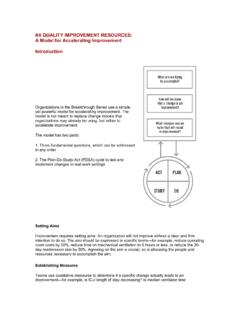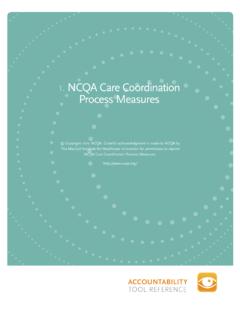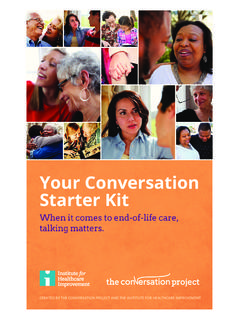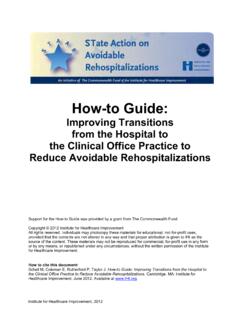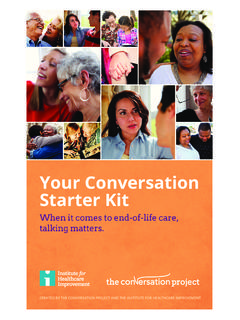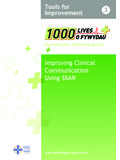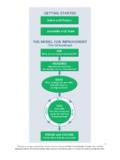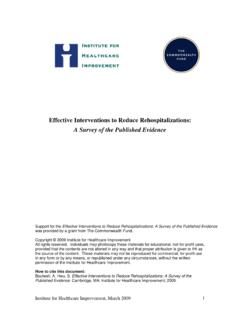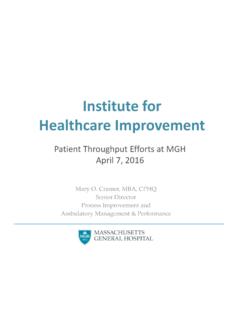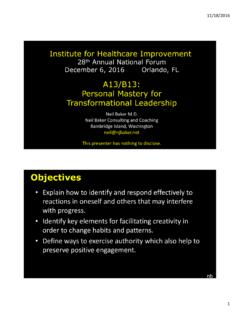Transcription of Partnering in Self-Management Support: A Toolkit for ...
1 institute for healthcare improvement Page 1 Partnering in Self-Management support : A Toolkit for Clinicians Partnering in Self-Management support : A Toolkit for Clinicians New Health Partnerships: Improving Care by Engaging Patients May 2009 The New Health Partnerships initiative is a national program of the Robert Wood Johnson Foundation at the institute for healthcare improvement funded to develop and test efficient approaches to empower patients and families to manage their chronic conditions. The program also engages patients and families as advisors to improve the design and delivery of health care services. institute for healthcare improvement Page 2 Partnering in Self-Management support : A Toolkit for Clinicians Contents Introduction .. 3 Collaborative Care: Cycle of Self-Management support .
2 9 Building Relationships .. 10 Gathering Clinical and Patient Experience Data .. 12 Provider Exam .. 14 Team Care: Nurse and Medical Assistant Coaching and support .. 17 Providing Ongoing Follow-Up .. 19 Sustaining Self-Management support : Training for Practice Teams .. 20 Sustaining Self-Management support : Community Partnerships .. 21 Sustaining Self-Management support : Partnering with Patients and Families .. 22 Sustaining Self-Management support : The Chronic Care Model .. 23 institute for healthcare improvement Page 3 Partnering in Self-Management support : A Toolkit for Clinicians Self-Management support is the assistance caregivers give to patients with chronic disease in order to encourage daily decisions that improve health-related behaviors and clinical outcomes.
3 Self-Management support may be viewed in two ways: as a portfolio of techniques and tools that help patients choose healthy behaviors; and as a fundamental transformation of the patient-caregiver relationship into a collaborative The purpose of Self-Management support is to aid and inspire patients to become informed about their conditions and take an active role in their treatment. Tom Bodenheimer, Helping Patients Manage Their Chronic Conditions , 2005 Introduction Helping patients and families manage chronic conditions is an idea whose time has come. Self-Management support is a central focus in the institute of Medicine Crossing the Quality Chasm report and the patient-centered medical home, and is receiving increasing attention in the continuing education programs of professional organizations, with good reason.
4 Many patients do not understand what their doctors have told them and do not participate in decisions about their care, which leaves them ill prepared to make daily decisions and take actions that lead to good management . Others are not yet even aware that taking an active role in managing their condition can have a big impact on how they feel and what they are able to do. Enabling patients to make good choices and sustain healthy behaviors requires a collaborative relationship, a new health partnership between health care providers and teams, and patients and their families; a partnership that supports patients in building the skills and confidence they need to lead active and fulfilling lives. The concepts and tools in this Toolkit are intended to give busy clinical practices an introduction to a set of activities and changes that support patients and families in the day-to-day management of chronic conditions.
5 Experienced organizations and teams will find tested resources and tools. Practices that are just beginning to reorganize for patient-centered care as well as those experienced in collaborative Self-Management will find tested resources and tools and high-leverage changes that offer a number of ways to begin trying them with a small number of patients. Where do I begin? Finding the time and learning the skills to partner with patients to support healthy behaviors is challenging given the demands on primary care today. But you can use the same skills and tools to change your practice as patients use to change health behaviors. Start small, choose one skill or process to change, try it with just a few patients, and then assess your experience. Engage others in your practice to take a role.
6 Together, you can problem-solve the issues that arise and build on your successes. Below are a few examples of ways to begin. institute for healthcare improvement Page 4 Partnering in Self-Management support : A Toolkit for Clinicians Build a shared agenda: Choose one of the agenda-setting tools in this Toolkit and use it with five patients. Did using it help to make the conversation more collaborative? Did it give you more information about each patient s concerns? Mail or link patients to one of the Visit Preparation Forms (see the section on Building Relationships below) to five patients before their scheduled visit. Did the patients have more questions? Was the conversation during the visit more productive? Provide clear information: After providing information about treatment or medication, use the Closing the Loop technique (see the section on Provider Exam below) with five patients.
7 Did patients have more questions? Set goals and make action plans: Ask five patients what they would most like to work on to improve their health. Note the goal in their chart, and then ask them to meet with a nurse or medical assistant to complete an Action Plan (see the section on Team Care below). Follow up on their next visit to see how they did. Choose a population of focus such as patients with diabetes with whom to test changes: Identify diabetes patients who have upcoming visits scheduled by reviewing the next day s appointments. Choose one of the tools in this Toolkit ( , the Action Plan form or other goal-setting tools) to test with this patient population. Place a copy of the tool in the chart in advance of the visit to remind the care team to review the tool with the patient.
8 Engage other members of the care team: Discuss the changes you are testing with the entire practice team. Are there ways that they can help prepare or complete some of the tasks so the visit goes smoothly? Assign roles and tasks to each team member to enhance each patient s care experience. Ask patients how they feel about the changes to the visit that you are testing? Getting their feedback early in your change process will help you become more effective. Finally, there are a growing number of practitioners and teams experienced in Self-Management support . You and your care team probably know more than you realize about supporting patients in Self-Management . As you dive deeper into Partnering with patients and families, the links and tools in this Toolkit will help you meet their Self-Management support needs.
9 institute for healthcare improvement Page 5 Partnering in Self-Management support : A Toolkit for Clinicians Evidence for Self-Management support Patient-centered Self-Management support improves health and physical function outcomes as well as patient satisfaction regarding care and can be accomplished with existing staffing models. Our confidence in these techniques and tools comes from the growing number of studies and reviews that provide evidence that helping patients and families manage chronic conditions improves outcomes. The tools and examples come from the experience of teams implementing Self-Management support in 35 health care systems in New Health Partnerships: Improving Care by Engaging Patients, a Robert Wood Johnson national program located at the institute for healthcare improvement .
10 The following papers provide evidence for the concepts and tools in this Toolkit , but do not comprise a formal or comprehensive review of the literature. Bodenheimer T, Lorig K, Holman H, Grumbach K. Patient Self-Management of chronic disease in primary care. JAMA. 2002 Nov 20;288(19):2469-2475. Evidence from controlled clinical trials suggests that programs teaching Self-Management support are more effective than information-only patient education in improving clinical outcomes, and Self-Management education improves outcomes and can reduce costs. Bodenheimer T, Laing BY. The teamlet model of primary care. Ann Fam Med. 2007 Sep-Oct;5(5):457-461. The 15-minute visit does not allow the physician sufficient time to provide the variety of services expected of primary care.


